Towards fusion energy 2023: the next stage of the UK’s fusion energy strategy
Updated 16 October 2023

(Adobe #281471336)
Foreword
Pulse no. 99971. To many, outside of the fusion energy community, this won’t mean anything, but for the prospects of fusion energy becoming commercially viable this is a landmark number. In February 2022, the UK-based Joint European Torus (JET) fusion experiment smashed the 1997 record for the most energy produced by more than double. This result and others like it around the world demonstrate how much closer we are to the goal of clean, safe and inexhaustible energy.
As the Minister for Nuclear and Networks, I am excited and inspired by recent successes in fusion R&D, both in the UK and elsewhere. I am determined to ensure that the UK remains at the forefront of global fusion leadership and can reap the benefits of commercialising a technology that could transform the global green energy market. The potential of fusion is enormous and now is the time to commit and invest in this historic opportunity to lead the global mission in fusion.
While the UK’s 2021 Fusion Strategy was trailblazing, the pace of change within the fusion industry means that to reap the economic and social rewards, the UK must be forward looking to stay ahead. This next stage of the UK’s strategy sets out how we will build on the vision set out in 2021 to expand our world-leading R&D capabilities, deliver new cutting-edge facilities and do more than ever before to support a diverse and vibrant fusion sector.
This strategy gives details of the new programmes we will be putting in place to secure the bright future of the UK fusion sector as part of Fusion Futures, the UK’s alternative programme to Euratom R&T. It includes new capabilities, such as a new fusion fuel cycle facility, enhanced support for fusion R&D and engineering firms and dedicated funding to grow engineering and science skills. We will continue to highly value our relationships with partners globally, including with the EU and ITER, sharing learning and using the UK’s unique experience to advance fusion in the UK and globally.
We estimate that more than half of the budget we earmarked for the new Fusion Futures programme will be spent in the private sector, with a significant amount also spent in universities. This represents an enormous boost to the UK’s whole fusion sector regardless of technology.
The UK remains a world leader in fusion energy development, the future we set out in this document shows how we will build on that and drive fusion energy closer and faster. The world needs fusion energy - this is how we will work with our partners and industry to deliver it.

Andrew Bowie
Parliamentary Under Secretary of State at the Department for Energy Security and Net Zero
Executive summary
In 2021 the UK published its first fusion energy strategy. This set out a vision for UK fusion that focussed not just on the UK’s unique scientific and technical expertise, but on commercialising that technology by developing a thriving UK fusion sector and collaborating internationally.
Over the last 2 years we have made significant progress. We are passing legislation to create a regulatory environment for fusion that ensures the safety of the public whilst encouraging and enabling innovation and investment. The concept design phase of our flagship fusion programme, the Spherical Tokamak for Energy Production (STEP) is well advanced. We’ve delivered a £50 million Fusion Industry Programme and developed new technical and scientific capabilities.
The objective of all these interventions has always been to stimulate the development of a thriving UK fusion sector and importantly, the supply chain to service it.
Objectives for UK fusion
For the UK to demonstrate the commercial viability of fusion by building a prototype fusion power plant in the UK that delivers net energy.
For the UK to build a world-leading fusion industry that supports different fusion technologies and is capable of exporting fusion technology in subsequent decades.
The context in which these interventions operate has continued to evolve rapidly over the last 2 years. We have seen considerable investment into a growing number of private sector fusion companies worldwide, often with ambitious timescales and a wide range of technical approaches. At the same time, we’ve seen increased competition for skilled resource and a tightening of the global investment market.
Figure 1 – The 3 pillars of the UK’s Fusion Strategy

- International
- Scientific and Technical
- Commercial
This updated strategy retains the 3 core pillars of international collaboration, scientific and technical expertise and commercialisation that were set out in the original strategy. It builds on the successes of the last 2 years and goes further, creating a new Fusion Futures Programme with a focus on supporting fusion sector development and enhancing UK leadership in an increasingly competitive field.
The 3 core areas of the Fusion Futures programme are:
Infrastructure
- Funding to further develop the UK’s fusion cluster, providing infrastructure and facilities for fusion companies that want to be part of that growing community.
- Development of a new facility to support research and innovation in fusion fuels generation, to be used by public and private sector alike.
Skills
- Creation of a new Fusion Skills Centre that will work with universities, colleges and employers, to provide a pipeline of highly skilled scientists, engineers and technicians at all career levels, from apprentice to post-doctoral fellow.
Industrial and commercial opportunities
- An expansion of the Fusion Industry Programme providing a wider range of challenges across multiple technological approaches to fusion.
- The UK is open to finding new ways to collaborate and share expertise with ITER. Exploring the development of a UK fusion investment fund, working with potential investors to provide patient capital to the growing number of UK fusion firms and suppliers.
The Fusion Futures programme represents up to £650 million of new investment, subject to business case approval, between now and 2027 on top of the existing fusion programmes. Further information is provided throughout this strategy. But more than that, it sets out the evolution of our approach to fusion energy. Having invested in creating a uniquely strong foundation in fusion R&D, it is time to look towards addressing broader sector needs, and ensuring the UK is in the best position possible to support and harness the creativity and drive it contains.
We will also be working closely with our international partners. Fusion is a global endeavour and the advantages of international collaboration in R&D are well understood. We want to use international collaboration to accelerate commercialisation and reduce the cost of fusion energy development for the UK and its partners.
We would like, if we can, to agree a new route for collaboration with ITER and we are already exploring new opportunities for innovative partnerships all over the world. We will also continue to work with the IAEA and like-minded partners on international regulation. It is essential, in the global context of climate change, that regulation safely enables innovation rather than stifles it.
Our fusion strategy in 2021 set out how we will start to build a globally competitive fusion sector. This update shows how we will adapt and enhance that approach to address a wider set of challenges and use the best of the public and private sectors to make fusion energy a reality.
Background
Since the launch of the UK government’s inaugural fusion strategy in October 2021, we have seen astonishing technical and commercial progress, both in the UK and globally, showing that more than ever before, commercially viable fusion energy may be within reach.
Figure 2 – Progress across the global fusion landscape since October 2021

| International | Scientific and Technical | Commercial |
|---|---|---|
| – New collaborations between UK organisations and other nations – Launch of the UK’s Euratom alternative R&D programme, Fusion Futures – The USA, Germany and Japan have announced their intentions and priorities for fusion. |
– World record results from JET (Joint European Torus) – Demonstration of ignition from the US National Ignition Facility – H3AT centre opened at Culham to research tritium processing |
– Over $6 billion has now been invested globally in private fusion industry – A site has been selected for STEP in West Burton, Nottinghamshire – 58 organisations supported through the Fusion Industry programme |
Given this pace of progress and change, we must continue to adapt and update our approach to the development and commercialisation of fusion power. The core pillars of international, scientific and technical, and commercial leadership will remain, but we will continually review how they are delivered to ensure the UK remains at forefront of this green energy revolution.
Energy context
Energy security is one of the most prominent challenges currently facing countries around the world. There is an increased focus on energy sources that are cheap, abundant and reliable which do not depend on other nations for either electricity generation or supply chains.
Plans to secure long-term energy security will need to consider the challenge of rising electricity demand. Electrification across whole sectors of global economies will result in a huge increase in electricity demand. International Energy Agency (IEA) analysis has suggested that global energy demand could increase by over 75% by 2050[footnote 1]. This trend is expected to continue into the next century.
Electricity demand is expected to rise in the UK as well. In 2022, the UK generated 326.0 TWh of electricity, of which 56.0% was from low-carbon technologies[footnote 2]. By 2050, the UK’s total electricity demand is expected to rise to 570-630TWh[footnote 3] which is nearly double the current electricity demand.
Figure 3 – UK estimated energy requirement for 2050[footnote 4]
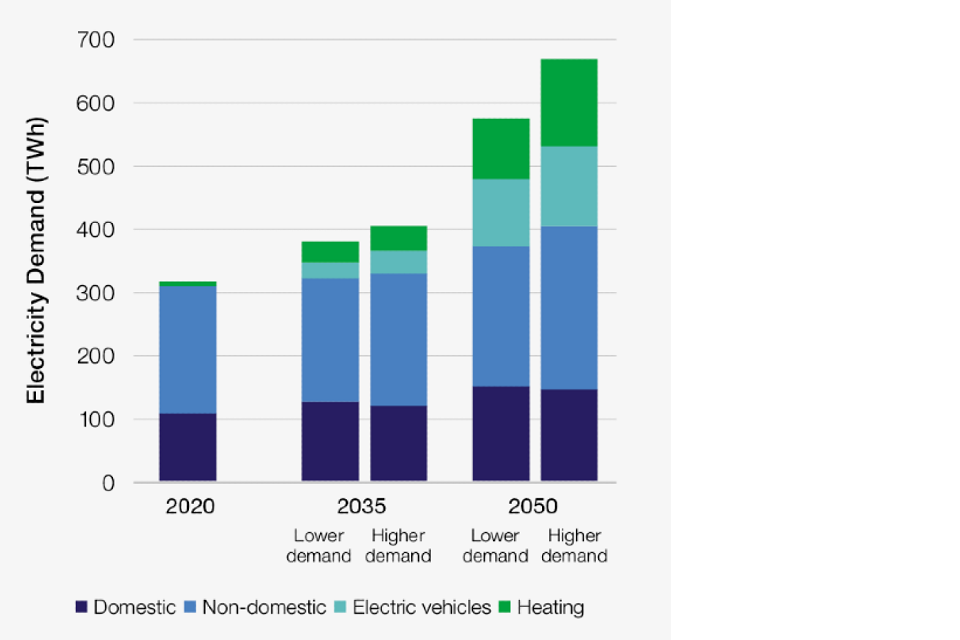
The need for a low-carbon, clean, reliable source of energy that can be generated in the country of consumption presents a huge opportunity for fusion to provide both global energy security and decarbonisation. Not only is there a large social impact in commercialising fusion, but there is also a huge economic opportunity for the UK to capture in addressing this challenge.
There are a wide range of estimates as to what share of the global energy market fusion will capture and the resulting levels of investment as a consequence of this. An average of these estimates implies a global fusion market of $6.9 trillion in the future. One nation would only be able to capture a proportion of this but as a global leader in fusion, the opportunity for the UK is enormous.
Environmental context As set out in the government’s ‘Powering up Britain’ plan[footnote 5], energy security and net zero are two sides of the same coin.
The UK needs to make sure that any future decarbonised energy mix system is reliable. This means intermittent renewables need to be complemented by technologies which can provide power when the wind is not blowing or the Sun does not shine. Fusion can provide some of this baseload low carbon power. Fusion can also provide a source of high-grade heat which will be needed in decarbonising many industrial processes.
The UK has set out a clear and consistent long-term policy framework through the ‘Energy White Paper’ in 2020[footnote 6] the ‘Net Zero Strategy’ in 2021[footnote 7] and in last year’s ‘British Energy Security Strategy’[footnote 8]. The commercialisation of fusion can help tackle these challenges and provide a long-term solution. For countries who do not have natural resources on which renewables rely or lack sufficient space for large power generating plants, fusion could be the key to unlocking global decarbonisation.
What is fusion?
Fusion is the process which occurs at the centre of stars. It is the source of light and heat emitted by the Sun. When the nuclei of two light elements are ‘fused’, they form a heavier element and release excess energy. Fusion energy can be generated in a variety of ways including but not limited to Magnetic Confinement[footnote 9] and Inertial Confinement[footnote 10]. All methods need to create an environment with sufficient heat and pressure.
The most common fuels considered for fusion power plants are deuterium and tritium, both of which are isotopes of hydrogen. In a deuterium-tritium fusion reaction, the nuclei of a deuterium atom and tritium atom fuse. This creates a helium nucleus and a highly energetic free neutron, whose energy can be harnessed to produce heat and electricity.
The generation of usable energy using fusion would have 6 distinct advantages:
- Fuel abundance: the fuels used in fusion reactions are effectively inexhaustible. Deuterium is readily extracted from seawater, and tritium is produced using lithium;
- Baseload power: fusion energy does not depend on external factors such as wind or sun, making it continuously deployable at point of need;
- High fuel efficiency: fusion produces more energy per gram of fuel than any other process that could be achieved on Earth;
- Carbon-free: helium is the product of the fusion process – no carbon or other greenhouse gases are produced in the reaction;
- No chain reaction: fusion is not based on a chain reaction; specific conditions of heat and pressure need to be maintained for fusion to occur. Therefore, if there were any technical problems, a fusion facility could be immediately switched off and the process would stop within seconds or less;
- Shorter lived waste: fusion power plants are not expected to produce the very long lived, high level radioactive waste associated with nuclear fission.
Figure 4 – A summary graphic of the fusion landscape in the UK

See a plain text version of figure 4.
Magnetic Confinement
In Magnetic Confinement Fusion (MCF), extreme heat strips electrons from nuclei to form charged ions as a plasma. To keep this very hot plasma from touching the sides of the machine and create density, powerful external magnetic fields confine and controls the plasma in a doughnut shape where fusion occurs. The magnets allow the fuel to be confined for very long periods. Common MCF devices include tokamaks (the technology for JET and STEP) and stellarators.
Inertial Confinement
Inertial Confinement Fusion (ICF) is an approach to fusion which relies on reaching very large pressures rather than confining the fuel for long periods. It is a pulsed process, like an internal combustion engine. At the heart of inertial fusion is a millimetre sized fuel pellet. This fuel pellet is made to implode through a rapid delivery of energy. As the fuel is rapidly squashed, it is heated and compressed, reaching fusion conditions and releasing a huge pulse of energy.
The main existing approach to inertial fusion uses a large laser as the energy input to drive the reaction. The laser is called the ‘driver’ and is like the spark plug in an internal combustion engine. There are other approaches to inertial fusion such as ‘projectile fusion’, which uses a high velocity projectile instead of a laser. The projectile impacts a target that integrates the normal fuel capsule within an ‘amplifier’. The amplifier technology focuses the energy of the projectile into the fuel capsule, which implodes identically as if driven with the more conventional laser approach.
The UK government’s fusion strategy
A changing fusion landscape
The global landscape of fusion is changing, and the commercialisation of fusion is accelerating. We are seeing results from a range of technologies, and investment continues despite a challenging investment market.
In the past, approaches to developing commercial fusion energy have tended to involve very large international collaborations to reduce the risks associated with the long timescales. But fusion technology of all kinds is maturing rapidly, including in the private sector where investment is growing, and some companies have ambitions to bring prototypes to market in the 2030s.
Large-scale ambitious and international programmes are needed to unlock investment, de-risk large-scale programmes through prototyping and grow the entire fusion sector. But they should be seen as only one strand of an approach that supports wider sector development and deployment at a pace that is commercially relevant and enables long-term decarbonisation.
This is to say that the public sector will not deliver fusion alone. Collaboration between public and private sectors will be crucial to tackle the remaining challenges of fusion and accelerate the commercialisation of fusion in a mutually beneficial approach.
The UK is uniquely positioned to capitalise on the huge societal and economic opportunities of fusion due to the expertise gained from hosting JET, the unique capabilities developed through its extensive fusion R&D programmes, its growing and dynamic fusion industry and its world leading proportionate, pro-innovation regulatory framework.
Government support for fusion
The support the UK government has been providing to the UK fusion sector has also increased to match the ambition of its fusion strategy. We have invested over £700 million from 2021 to 2022 to 2024 to 2025 to support the UK Atomic Energy Authority’s (UKAEA) cutting-edge research programmes and facilities and £126 million in 2022 to boost UK fusion programmes[footnote 11].
On 7 September 2023 the government announced that the UK will not associate to Euratom R&T and by extension, the Fusion for Energy Programme. Instead, the UK will launch the Fusion Futures Programme. This programme will be an ambitious and cutting-edge suite of new R&D, and to deliver Fusion Futures the government plans to invest up to £650 million up to 2027 subject to future business cases. This funding will be repurposed from what was ringfenced for Euratom association and will be in addition to the £826 million already invested. The UK remains very open to collaboration with the EU and other international partners, and this will form a key part of this new programme of work.
When this package was initially announced on 7 September, the government promised to follow up with further detail of what will be delivered to support the UK fusion sector. As well as setting out the UK’s priorities amongst the changing global fusion landscape, this update to the UK’s Fusion Strategy provides this and demonstrates how Fusion Futures will support development of the wider UK fusion sector. Throughout the strategy, programmes which relate to Fusion Futures will be emphasised.
UK objectives
The changing landscape of fusion has not changed the UK’s overall objectives from the last strategy, but the UK will now be able to talk in further detail about how we will achieve these goals.
Objectives for UK Fusion
For the UK to demonstrate the commercial viability of fusion by building a prototype fusion power plant in the UK that delivers net energy.
For the UK to build a world-leading fusion industry that supports different fusion technologies and is capable of exporting fusion technology in subsequent decades.
International leadership
The Integrated Review Refresh in 2023 committed to building on the UK’s strategic advantage in science and technology as a core national priority[footnote 12]. To achieve this the UK will need to utilise its global leadership to promote the benefits of fusion, build consensus, accelerate breakthroughs in fusion technology and remain at the forefront of research.
Objectives for fusion international leadership
To use international R&D collaborations to accelerate the commercialisation of fusion energy.
To reduce the cost and risk of UK fusion programmes through collaboration, while protecting UK intellectual property and competitive advantage.
To lead the development of international fusion standards and regulation, to ensure safety and maximise the global potential of fusion whilst creating important market opportunities for the UK.
The UK has already established several strong international collaborations with like-minded countries as part of its international fusion objectives. These maximise the progress of fusion science and economic opportunities for UK businesses, whilst protecting the UK’s competitive advantage.
Existing collaborations have included R&D agreements between technical labs and harmonising fusion regulatory frameworks as part of multilateral discussions through Agile Nations[footnote 13] and the International Atomic Energy Agency (IAEA). The UK is already sharing its knowledge of fusion regulation bilaterally with several countries.
Figure 5 – A summary graphic of UK collaborations with other countries

USA: Agreement between UKAEA and Commonwealth Fusion Systems. Cooperation agreement on physical sciences including fusion.
Canada: Discussions on regulation as part of agile nations and bilaterals.
Japan: £12 million robotics deal for fusion and nuclear decommissioning; discussions on regulation as part of Agile Nations.
South Korea: MoU on remote handling for fusion powerplants; bilaterals on regulation and R&D collaboration.
Singapore: A Strategic Partnership including, sharing information on fusion energy was announced on 7 September 2023.
IAEA (VIienna): The UK has been heavily involved in the IAEA’s fusion regulation work, including hosting the Fusion Energy Conference 2023.
EU: The UK has hosted JET since 1983 and we remain open to collaboration with the EU and ITER.
Moving forward, the UK wants to build and develop these relationships in the areas of R&D, regulation and skills across academia, national labs and industry. As part of Fusion Futures, we remain very open to collaboration with international partners.
As with most R&D endeavours, the pooling of resources increases the benefits, increases the chance of success and reduces the risk. As part of Fusion Futures, the UK will aim to invest up to £25 million to maintain existing and explore new international collaborations. This programme will look for opportunities to export UK academic and industrial expertise and make best use of global knowledge to accelerate fusion energy while protecting UK interests. These international collaborations would also give the UK fusion sector access to new capabilities which otherwise would have remained inaccessible and develop new pipelines for talent to enter the UK.
Given the UK’s expertise in MCF from hosting JET, most of the UK’s collaborations have focused on this technology. However, the global fusion market with specialisms in other fusion technologies such as inertial fusion can provide opportunities for the UK. The UK will ensure that international collaborations also include technologies beyond magnetic confinement which will support the development of a wide range of technologies in the UK and internationally.
What’s next:
- Build on existing collaborations with international partners to share expertise and accelerate the development of fusion technology.
- Develop options to support the UK inertial fusion sector through collaborations with key strategic partners.
Scientific and technical leadership
The UK has long been a leader in fusion research, with dedicated fusion research facilities since the 1950s.
Figure 6 – Image of Zeta project from the 1950s
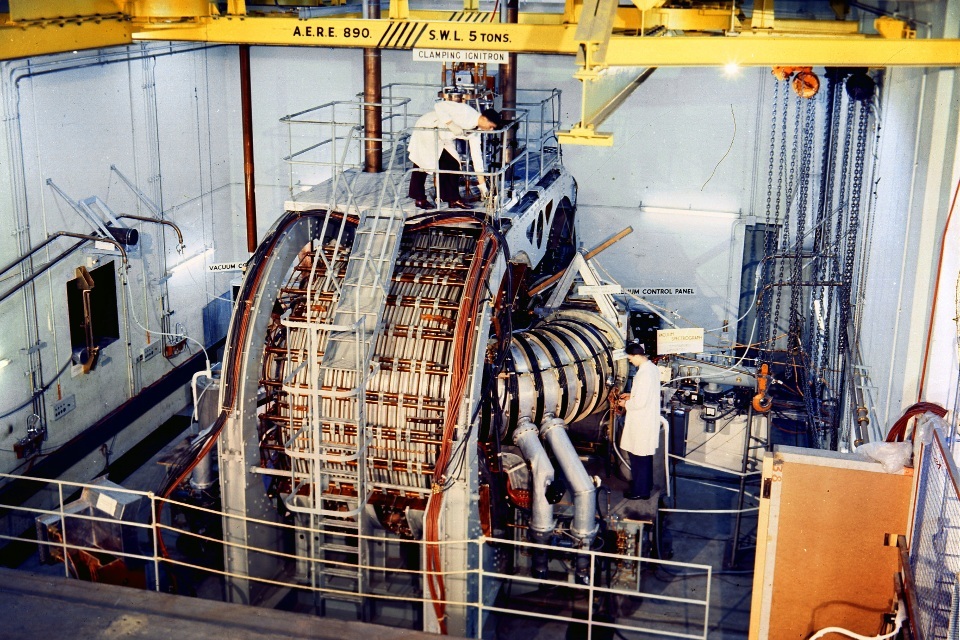
(©UKAEA)
There remain significant technical challenges before fusion is commercialised and further research is needed to continue to optimise fusion facilities. To remain as a frontrunner in the race to commercialise fusion, the UK’s technical leadership must continue to be comprehensive across the different challenges of fusion.
As breakthroughs in fusion-related technologies occur, the UK must also be able to translate this into a viable product, as well as being able to export this to other fusion projects around the world. In order to do this, the UK must maintain and develop world-leading scientists, researchers and engineers, remain up to date and forward looking when developing R&D programmes and maintain our cutting-edge research facilities.
Objectives for fusion scientific and technical leadership
- Maintain global leadership in fusion science, technologies and facilities.
- Attract, grow and retain leading fusion talent, including supporting engineering disciplines.
JET is the most powerful fusion device and largest fusion experiment in the world, hosted in Oxfordshire by UKAEA. Over 350 scientists and engineers from all over Europe contribute to the JET programme. By hosting JET, the UK has unique experience of operating the world’s premier fusion facility.
In 2021, JET set new records for power generation, producing 59 MJ of energy over 5 seconds. This more than doubled its previous record. It was collectively used for fusion research under EUROfusion’s management by more than 40 European laboratories but was moved into UK ownership in October 2021. In November 2022, the UK announced £84 million in advance of a decision on Euratom association to continue the operation of JET[footnote 14].
However, the JET fusion experiment is coming to the end of the operational phase of its working life. From the end of 2023, the UK will start decommissioning JET which will be the first time any fusion device of this size and complexity will be decommissioned. This will give the UK the unique opportunity to learn about the challenges of such an endeavour that can inform the UK when developing plans for commercial fusion facilities, develop Intellectual Property (IP) and allow the UK to identify and maintain the required skills to decommission fusion power plants of the future. Fusion companies based at Culham could also benefit from utilising JET systems.
Figure 7 – Internal view of the Joint European Torus vessel
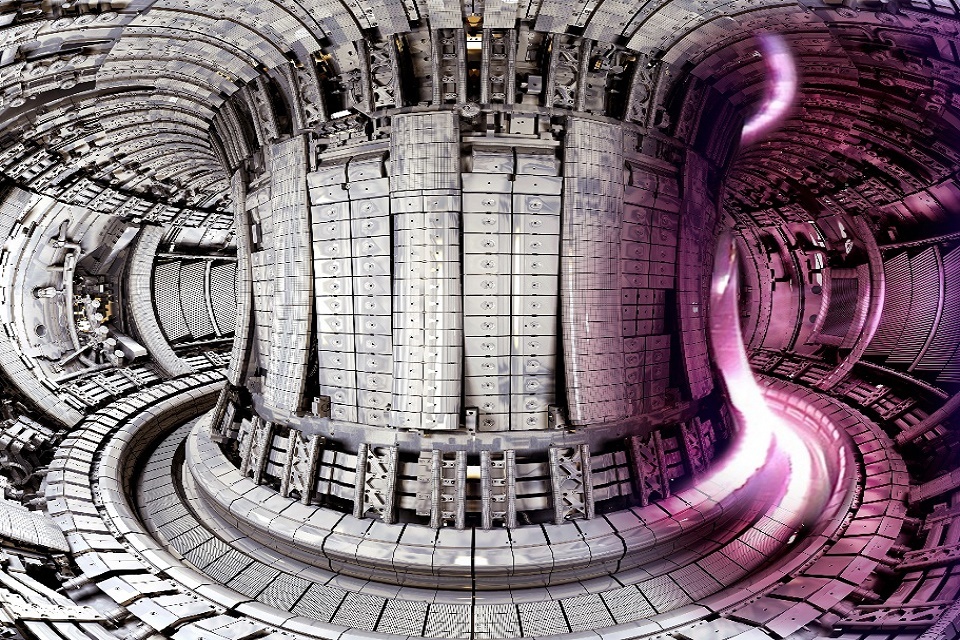
STEP
This will be important for programmes such as the Spherical Tokamak for Energy Production (STEP) programme. Hosted in West Burton, Nottinghamshire, the STEP Programme will design, develop and build, by 2040, a prototype fusion power plant capable of delivering net energy. So far, the government has committed over £240 million up to 2024 for the first tranche of STEP. With tranche 2a commencing in 2024, this will take government funding to over £300 million up to 2025. This tranche will generate standalone benefits such as the creation of skills and expertise, producing data and IP and the development of UK supply chains.
STEP will play an important role in demonstrating the commercial viability of fusion by integrating and operating industrial-scale fusion systems in a single, energy-producing facility which will galvanise the entire fusion sector in the UK. This ambitious and highrisk programme will do far more than just demonstrate fusion energy. It is designed to be done in partnership with the private sector, driving development of a supply chain, and industrial capability that is useful to a whole range of fusion technologies, not just the approach taken at STEP.
This approach is already bearing fruit; in 2016 before the UK started to transform its approach to fusion energy, the UK Atomic Energy Authority had contracted with around 200 companies and organisations. In 2023 that number is over 4,000, representing significant investment going into the UK economy.
Figure 8 – Representation of STEP

(©UKAEA)
UK R&D facilities
The UK has a suite of other R&D facilities that are developing technical solution to the challenges of commercialising fusion displayed below.
Figure 9 – The 6 challenges of magnetic confinement fusion and the roles of UK-based facilities and experiments in addressing them

See a plain text version of figure 9.
UKAEA’s MAST-U (Mega-Amp Spherical Tokamak - Upgrade) is an innovative type of fusion facility that is designed to investigate the viability of fusion power production at a reduced scale and cost. The original MAST experiment operated from 2000 to 2013. Its impressive performance led to a major upgrade, which completed in 2020. In 2021, this upgrade led to a tenfold reduction of the heat from the plasma reaching surrounding components.
Fusion devices need to manage temperatures hotter than the centre of the Sun metres away from ultra-low temperature cooling systems. Therefore, a tenfold reduction of heat represents a big step in developing technology that will allow commercial fusion energy facilities. If components in future machines will not be subjected to as much heat, they will last much longer before needing to be replaced.
Figure 10 – External view of the MAST-U device
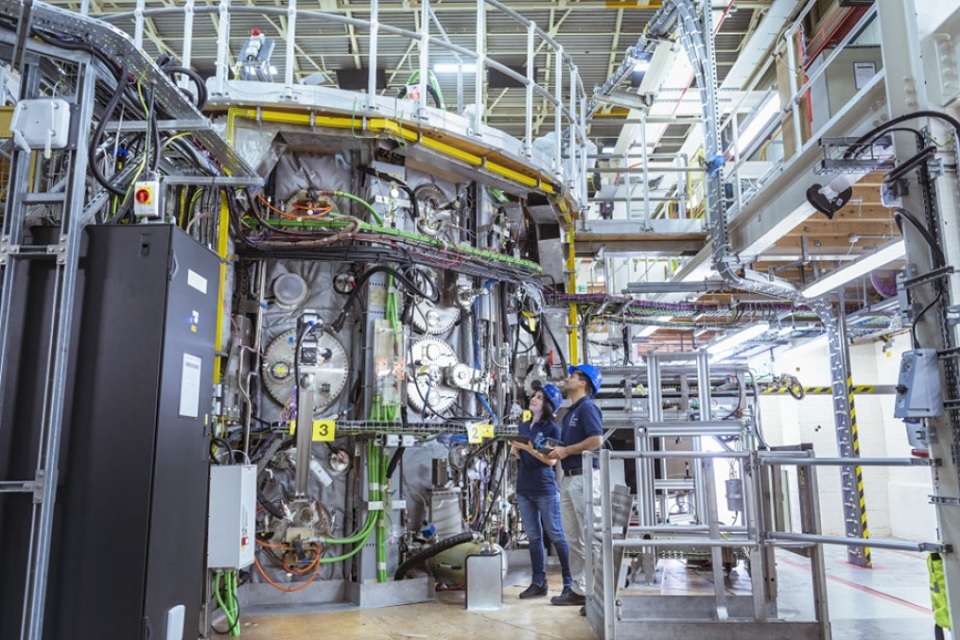
(©UKAEA)
The Remote Applications in Challenging Environments (RACE) Robotics Centre develops robotic solutions necessary to operate and maintain a commercially viable fusion facility. This will be key in making repairs to the inside of a fusion device and decommissioning a facility at the end of its life. RACE has other adjacent applications such as petrochemical, space exploration, defence and nuclear decommissioning. Private and public sector partners use RACE for their own experiments and work with the experts at the centre. In January 2021, UKAEA and Japan signed a collaboration agreement for a project called ‘LongOps’ which will support Fukushima decommissioning using long-reach robotic arms[footnote 15].
Figure 11 – Engineers at the RACE facility
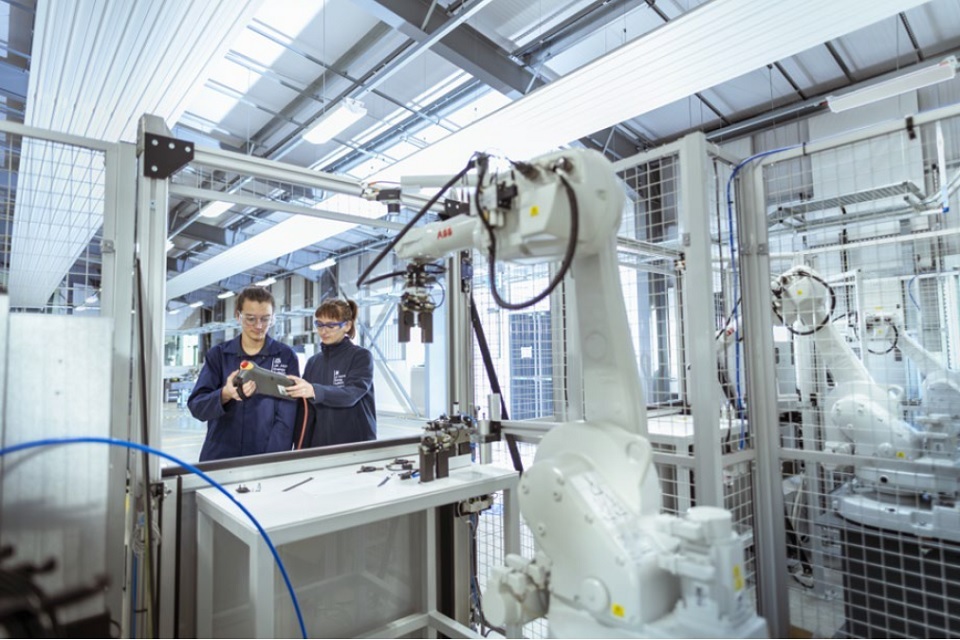
(©UKAEA)
The Materials Research Facility (MRF) is a centre dedicated to the exploration of advanced materials required for fusion. As the environment inside an operational fusion device is so unique with high temperature and fast neutrons, the materials developed are of high interest to the wider nuclear sector. Being able to test in these environments is also of interest to academics and businesses.
The Central Laser Facility (CLF) at the Science and Technology Facilities Council (STFC) Rutherford Appleton Laboratory is one of the world’s leading laser facilities, providing scientists from the UK and Europe with an unparalleled range of state-ofthe- art laser technology. Here they study fundamental physics for creating the dense plasma needed for ICF. In September 2023, STFC were awarded £85 million to construct Vulcan 20-20, which is set to be the world’s most powerful laser.
Figure 12 – The Vulcan laser at CLF used to conduct fusion experiments
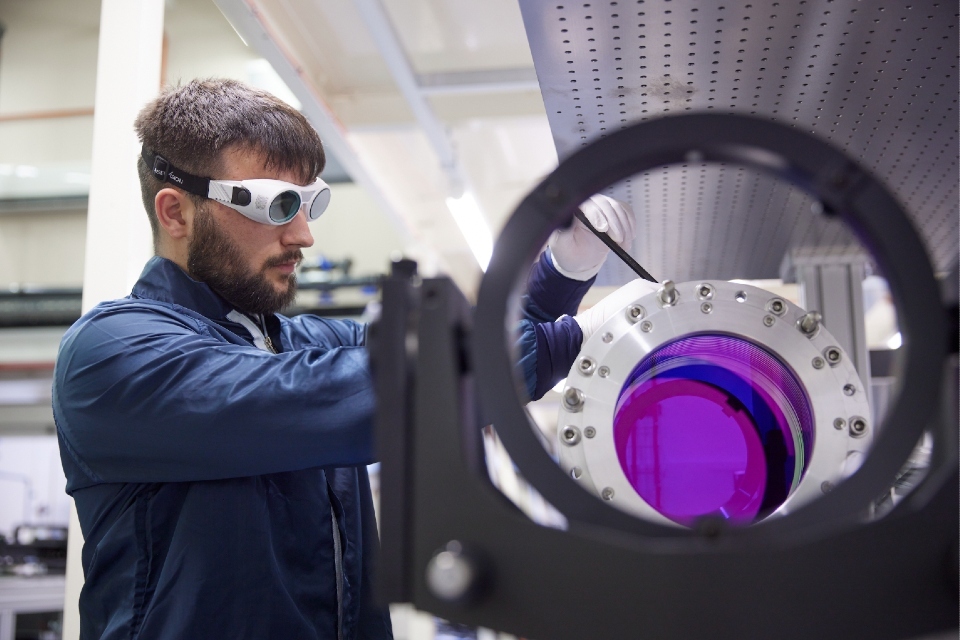
(Credit: Fisher Studios. CLF/STFC)
The Hydrogen-3 Advanced Technology (H3AT) centre opened at Culham in June 2022, and represents the largest fusion tritium research centre in the world. This centre will research tritium breeding, processing, distribution, storage, recycling and disposal which will be crucial for enabling commercial fusion energy facilities.
The ability to breed, store and recycle tritium is a key difference between most research and commercial fusion facilities. Commercial facilities will need to breed their own fuel and recycle it to sustain the fusion process. For MCF this will mean using fast neutrons to create tritium from lithium blankets surrounding the plasma. For other fusion technologies, tritium will still need to be bred but would likely involve other methods rather than blankets. All technologies will require tritium to be processed, handled and stored.
As part of Fusion Futures, the UK will aim to invest up to £200 million to build a fuel cycle testing facility to develop technology in Li-based tritium breeder solutions, advanced neutron diagnostics, and integrated tritium production solutions. This facility will be unique and will help tackle a key challenge in the global commercialisation of fusion, create new opportunities for universities and industry both within the UK and internationally. This facility will also make the UK a leader in tritium intellectual property and provide the UK opportunities to export tritium related technologies.
What’s next:
- The UK plans to build a fusion fuel cycle facility partnering with academia and industry to solve one of the biggest challenges of commercialising fusion.
- The UK will utilise the learnings from the decommissioning of JET to develop the technical skills and expertise for fusion power plants of the future.
- The UK is open to finding new ways to collaborate and share expertise with ITER.
Commercial leadership
The UK has already shown its leadership in fusion research, but this will need to be translated into commercially viable products. There are opportunities to develop spinoff technologies, but also have wider applications. As part of this strategy, the UK wants to create an environment in which these technologies can be developed and then commercialised.
The government has invested in fusion programmes, facilities and infrastructure to boost the capability of the UK supply chain and create new opportunities for fusion companies to locate, collaborate and innovate in the UK. This has created a flourishing private sector in the UK and will help to de-risk commercial investment into UK fusion innovation and accelerate the growth of the sector.
Objectives for fusion commercial leadership
- Create a vibrant fusion technology cluster (or clusters) in the UK
- Attract inward investment into fusion and related technologies
- Develop the supply chain and skills base to support fusion delivery and equip UK firms to compete successfully in a future global fusion market
As described above, the STEP programme will design, develop and build, by 2040, a prototype fusion power plant capable of producing net energy. This programme complements the work of all private fusion companies in the UK, regardless of technology, by acting as a magnet for global investment, a driver of supply chain innovation and a source of skills and expertise for the growing UK fusion sector.
To deliver STEP, the announced the intention to establish UK Industrial Fusion Solutions Ltd (UKIFS) as a delivery body in February 2023. This body will be fully formed by August 2024 and the first steps have been taken by appointing a Chair. UKIFS will drive performance at pace and engage with the fusion industry in delivering STEP.
The development of STEP brings huge economic opportunities both in the local area and across the UK through the development of supply chains. The government will work with local and regional authorities to maximise the benefits of STEP as part of the government’s ‘Levelling Up’ agenda.
Figure 13 – The West Burton site before being developed for STEP
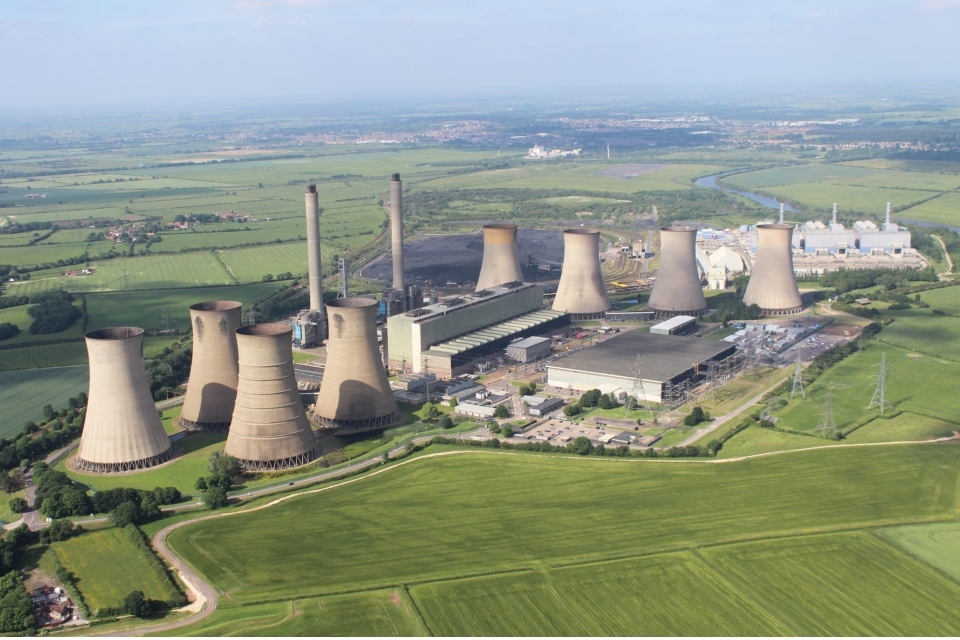
(© UKAEA)
As part of Fusion Futures, the UK will invest up to £11 million to further support the STEP programme and upskill UK industry to deliver it. We will implement an enhanced component design programme, engaging industry and UK science and engineering talent to build key components for future use in the STEP programme. The fusion sector will be able to benefit from enhanced knowledge-transfer between public sector fusion expertise and private industrial capabilities.
In November 2022, the government announced an investment of £42 million for the Fusion Industry Programme (FIP). The main component of FIP will galvanise and challenge the fusion industry to solve the important technical challenges of fusion helping to develop valuable intellectual assets and capabilities. It will also increase the supply of sought after skills in the fusion sector and make those skills more accessible for UK fusion businesses and STEP. So far FIP has awarded 56 contracts worth £31.25 million supporting 91 companies including sub-contractors.
The FIP programme is due to run until 2024 to 2025 but the UK aims to continue and expand the scheme as part of Fusion Futures, committing up to £35 million in addition to previous funding to do so. As part of a revitalised FIP programme, UKAEA will partner with fusion companies to set and review the challenges set by FIP while ensuring appropriate measures are taken to prevent any conflicts of interest. This will help ensure challenges set as part of this programme provide the maximum benefit to industry. The government will also explore an agreement for industry to access a wider range of UK facilities that would be beneficial for fusion research as part of the FIP voucher scheme.
In 2020, the government launched the Fusion Foundations programme, investing £184 million to transform the UK’s Culham campus into a global hub for fusion innovation. The UK government has also supported the Fusion Cluster, a community of public organisations and businesses collaborating at the Culham Fusion Campus to share knowledge and drive fusion energy from theory to reality. Since forming last year, the Fusion Cluster already has 205 members. Members can access cutting edge technical facilities, start-up business support and experienced peers.
Figure 14 – A representation of the future campus at the Culham Centre for Fusion Energy

(© UKAEA)
As part of Fusion Futures, the UK government plans to invest up to £50 million in addition to Fusion Foundations to transform the Culham campus. Part of which includes constructing new tenancy buildings to host fusion facilities for private companies. UKAEA already has agreements with First Light Fusion and Tokamak Energy to build their next facilities at Culham.
This could create the highest concentration of fusion companies in the world, making it attractive for potential investors and driving inward investment in the UK. The benefits of such are already apparent as the UK is discussing interest in replicating this arrangement with others.
The UK will build on the commercial success of UKAEA programmes and the UK private sector. We will aim to invest up to £18 million to establish a Technology Transfer Hub to proactively bridge the gap between the UK’s world leading research and protected IP that can be exported or integrated into programmes worldwide.
This will be achieved by nurturing and accelerating innovations that demonstrate economic and scientific impact and strengthening connects between research, corporate and entrepreneurial communities. The success of this programme will demonstrate the near-term economic impact of fusion and help make the case for continued investment. The Technology Transfer Hub will consider all fusion technologies and spillover benefits into other sectors.
Case study from Tokamak Energy
About us
Tokamak Energy is a leading global commercial fusion energy company based near Oxford, UK. We have an unrivalled track record designing and operating spherical tokamaks, the optimal route to commercial fusion energy.
In addition to fusion energy, Tokamak Energy is recognised as the leader in High Temperature Superconductor (HTS) magnets, design, numerical modelling, and prototyping. Our dedicated HTS magnet team, in collaboration with key manufacturing partners, is focused on becoming the leading supplier of HTS magnets to multiple markets.
The company currently employs a growing team of over 250 people with experts from the UK and around the world. It combines world leading scientific, engineering, industrial and commercial capabilities. The company has over 75 families of patent applications and has raised $250 million, comprising $200 million from private investors and $50 million from the UK and US governments.
Our technology
Tokamak Energy is pursuing the global deployment of commercial fusion through the combined development of spherical tokamaks with high temperature superconducting (HTS) magnets.
Spherical tokamaks are significantly more efficient than conventional tokamaks and can achieve improved energy output for a lower energy input and reduced capital costs.
In addition to fusion energy, Tokamak Energy is recognised as the leader in HTS magnet design, numerical modelling, and prototyping. We aim to provide magnet systems for other fusion companies to accelerate the industry, as well as to address exciting new applications for HTS, including propulsion in water, air and space, renewable energy and science.
Our track record
Our pathway to commercial fusion is built on proven science and an unrivalled track record. We are the only private fusion company with over a decade’s experience designing, building and operating spherical tokamaks.
Our world firsts:
- 2015 - First HTS tokamak sustained pulse for >24 hours (ST25 HTS)
- 2017 - Designed, built and operate the world’s highest magnetic field spherical tokamak (ST40)
- 2020 - World-record 24 Tesla field at 20K with patented HTS magnet technology
- 2022 - First private fusion company to achieve 100 million degrees Celsius plasma ion temperature in a tokamak, the threshold for commercial fusion
- 2022 - Highest plasma ‘triple product’ of any private fusion company, a key measure of plasma temperature, density and confinement time
Our future plans
We’re on a mission to have commercial fusion power plants deployed in the 2030s. We have completed design work on our next advanced prototype fusion device, which has the potential to de-risk and accelerate the development of multiple technologies required for the delivery of sustainable fusion energy. This device, scheduled for build completion in the late 2020s, will also demonstrate multiple advanced technologies required for fusion energy and inform the design of a fusion pilot plant. The fusion pilot plant will demonstrate the capability of delivering electricity into the grid in the 2030s, paving the way for globally deployable 500-megawatt commercial plants. We are extremely excited about the UK’s investment in STEP and we believe we can bring real value to the programme with our extensive knowledge of spherical tokamak design and operation, along with our HTS magnet technology.
Case study from First Light Fusion
First Light Fusion (FLF) is pursuing fusion energy using its novel ‘projectile and amplifier’ approach, inspired by the only natural phenomenon in the world that produces an inertially confined plasma. The company span out from the University of Oxford in 2011, stemming from the PhD research of founder, and now CEO, Nicholas Hawker.
In April 2022, FLF delivered its maiden fusion result, validating its approach. This was delivered for a total of £45 million and funded entirely through private equity. In February 2022, FLF raised another £33 million, bringing the total funding to £78 million. FLF has been described by ‘The Economist’ as “the leader of the inertial-fusion pack” due to its successful fusion result, its experimental assets and well-established simulation capabilities.
With a proven concept, the strategy to commercial power plants is clear and the programme is underway, with the prototype power plant expected in the early-to-mid 2030’s. The design sidesteps many of the major engineering challenges of many other approaches to fusion.
The next step towards the power plant is an ignition demonstration. FLF is designing and building Machine 4, which will be the largest pulsed power machine in the world, to meet this objective. FLF is targeting 2027 for the delivery of Machine 4. First Light is confident in its ability to complete the project on time and to budget and can reference its successful delivery of Machine 3 on time and to budget. A full project delivery plan for this has been developed. The machine is highly modular, allowing the building of a prototype first module in parallel with progressing the build overall. The company will simultaneously develop the conceptual design of the pilot plant, the next milestone towards commercialisation.
FLF has an agreement with UKAEA, planning the design and construction of a new purpose-built facility to house Machine 4 at UKAEA’s Culham Campus in Oxfordshire and the company is also working closely with UK government on a proposal regarding Machine 4 which would allow access for the wider scientific community to the experimental asset.
In addition to working closely with UK government, FLF has excellent relationships with the international fusion community, including academia and leading national labs, including Laurence Livermore Laboratories, and Sandia National Labs (home of the Z Machine) in the US, and is working on experimental projects with partners globally.
Figure 15 – Render of Machine 4
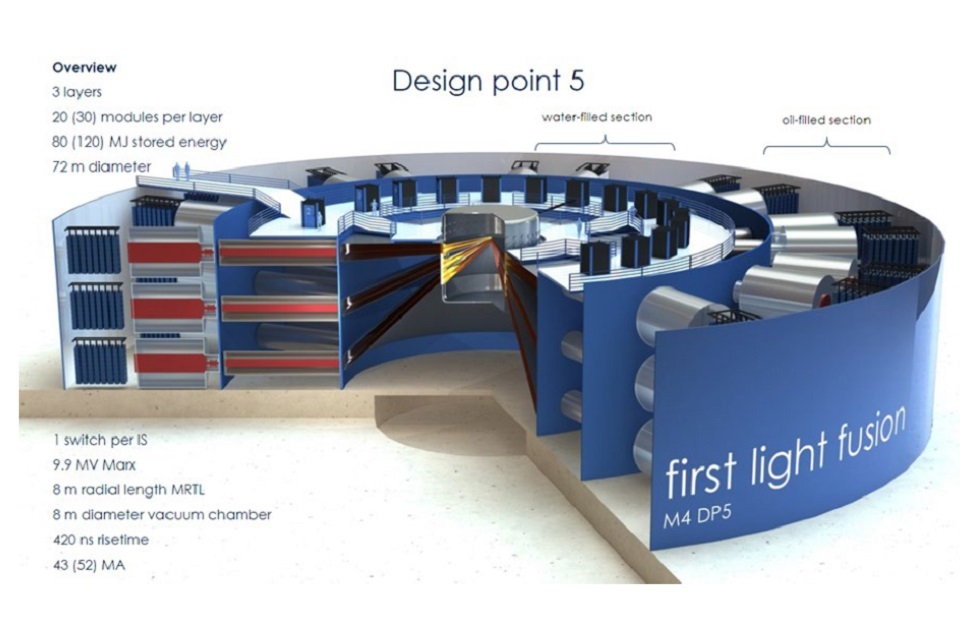
What’s next:
- The UK will develop its fusion cluster potentially creating the highest concentration of fusion companies in the world at the Culham campus in Oxfordshire.
- The UK will develop options to drive investment into UK companies and support a wide range of technologies, including exploring the development of a UK fusion investment fund, providing patient capital to the growing number of UK fusion firms and suppliers.
- The UK will invest up to £18 million to establish a Technology Transfer Hub to be proactive in bridging the gap between research and commercial technology.
Enablers
Skills
People are the greatest national asset that a country can have. People provide the ideas, carry out the research, build the technology and operate the machinery that can transform a country’s R&D capability.
The UK is already a hotbed of industrial and academic fusion talent building on its long history of fusion research as set out in the scientific and commercial leadership chapter of this strategy. UKAEA is a beacon of technical fusion expertise – now the largest fusion organisation in the world employing 2400 people - and UK fusion academics are leaders in their field.
The UK Atomic Energy Authority (UKAEA) runs the Oxfordshire Advanced Skills (OAS) Centre at its Culham Campus, in partnership with the Science and Technology Facilities Council. Since 2019, the expanded OAS Centre trains 460 learners for UKAEA and 35 industrial partners, with 80% of apprentices going to local industry. Specialising in areas such as power engineering, AI, robotics and nuclear design, OAS apprentices routinely win local and national awards. The OAS programme will expand with centres at Harwell and create the East Midlands Skills Centre at West Burton, Nottinghamshire.
Despite this, the UK cannot assume the needs of the future fusion industry will be met without support. To create a thriving fusion sector that provides commercial energy to the grid, the UK will need to start expanding its a highly skilled, multi-disciplined, diverse fusion workforce now. The size of this workforce will then need to ramp up as the commercialisation of fusion becomes reality.
Figure 16 – UKAEA scientist and trainee
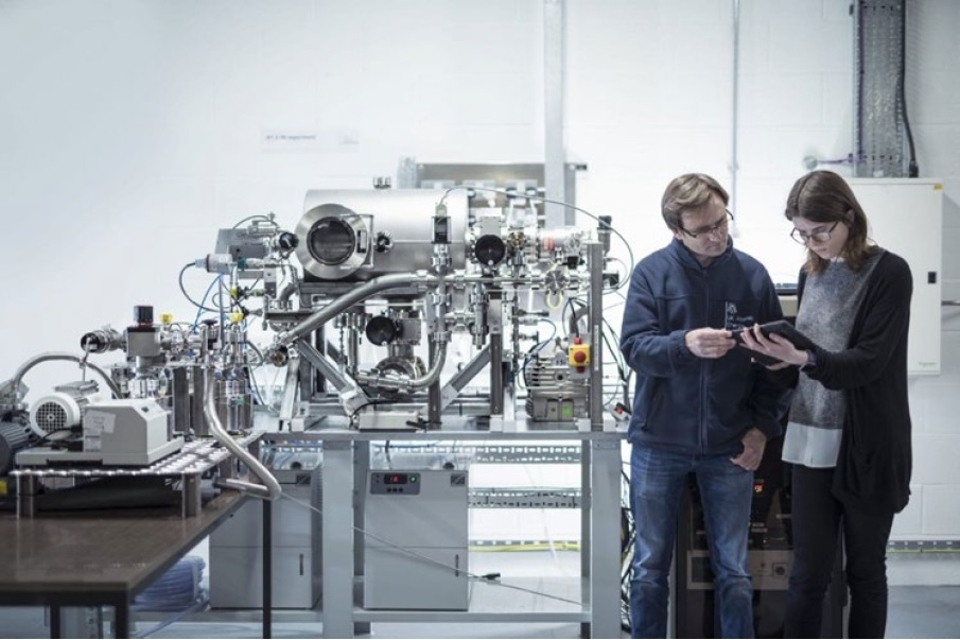
(© UKAEA)
The Fusion Skills Council[footnote 16] have estimated that the fusion workforce will need to grow by at least 3,000 people within 5 years and by 7,000 people within 10 years. This is likely to be an underestimate of the needs of the entire sector. This presents a significant challenge to fusion when S&T skills are in high demand worldwide.
The UK has the ambition that the current and next generation will see fusion energy as a career choice in its own right, as they would view the aero, space, automotive and medical sectors. We will boost the fusion talent pipeline across all levels from apprentice to post-doctoral and tackle not only technical skills but generalist too such as programme and supply chain management.
As part of Fusion Futures, we plan to invest up to £56 million in a Fusion Skills Programme to train over 2,200 people in the next 5 years by working with business to increase the number of apprentice and graduates, universities to increase the number of fusion postgraduate and PhDs and international partners to increase post-doctoral opportunities.
The investment will initially be for UKAEA to expand their skills offering across all qualification levels with the expectation that partners match government funding. This programme will also aim to increase the transfer of skills into the fusion sector and broaden the geographic offering of fusion training and represent a significant outreach programme, particularly targeting under-represented groups.
We will also support international fellowships to attract the best talent into the UK and identify opportunities for UK talent to gain exposure to opportunities abroad.
Figure 17 – UKAEA engineers

(© UKAEA)
Regulation
Objectives
Regulation ensures the safety of the public, workers and the environment. It is also crucial for the feasibility of a technology and for the ability to export that technology. A good regulatory framework is:
- Proportionate to the hazard and risks of a technology to maintain safety while not creating endless red tape.
- Transparent to build developer and public trust.
- Encourages innovation so a technology can be optimised after first-of-a-kind designs and new technologies can be developed.
Progress
Alongside the inaugural fusion strategy, the government published a consultation on the regulatory framework for fusion energy. The core proposal of this framework was for fusion energy to continue to be regulated by the Health and Safety Executive (HSE) and the Environment Agency (EA) rather as a nuclear installation which was confirmed in the government’s response to the consultation[footnote 17]. This decision was based on work with the UKAEA’s Fusion Safety Advisory Group[footnote 18].
To provide clarity to the UK fusion industry, the government introduced legislation as part of the Energy Bill[footnote 19] which confirms that the Nuclear Installations Act 1965 would not apply to fusion energy facilities. This would mean that fusion would not be regulated in the same way as fission facilities. The Energy Bill is expected to become law in 2024.
The UK demonstrated leadership in being the first nation to set out its proposals for fusion energy regulation and has backed this up by introducing legislation. However, there is still more to do to confirm the regulatory landscape for fusion developers internationally and domestically.
Since publishing its proposals, the UK has been working to share the knowledge gained through the policy making process with other countries. A global harmonised approach that is proportionate, transparent and pro-innovation would maximise the global benefits of fusion by reducing barriers to exporting fusion technologies, ensure human and environmental safety and improve public trust.
Going forward
Agile Nations is an inter-governmental regulatory network designed to foster cooperation on innovative regulatory practice. The fusion energy work group, comprising of the UK, Japan and Canada as members with Singapore and Bahrain as observers, are discussing how nations can approach developing a regulatory framework for fusion energy facilities. This group has published its recommendations in parallel to this strategy.
The IAEA set safety codes and standards for nuclear fission and while fusion energy is a different process, with different inherent features, the IAEA is considering what safety codes and standards could look like for a fusion energy facility. The UK is at the forefront of providing technical information into this work to ensure any future codes or standards are robust and proportional.
Domestically, the government plans to introduce a National Policy Statement for Fusion Energy. This will set out the policy and strategic rationale for constructing fusion energy facilities and streamline the development process for STEP and private developers.
A recent consultation was conducted seeking views on proposals to update and consolidate the policies of the UK government and devolved administrations on managing radioactive substances[footnote 20]. One of these proposals is to amend current policies on implementing geological disposal to make clear that not all Intermediate Level Waste (ILW) needs to be disposed of in a geological disposal facility, where it is safe to do. This could have implications for the storage of radioactive waste from fusion as it could be stored in a near surface disposal facility. The government will consider the outcome of this consultation to inform policy on fusion waste.
The government’s response to the fusion regulatory consultation committed to developing positions in the following policy areas:
- Third party liability - to ensure requirements of fusion developers are proportionate but developers are held accountable for any harm caused to the public, workers and the environment. The fusion supply chain would benefit from clarity on whether they would be held liable in event of a fusion accident. Third party liability requirements are set internationally so the UK will work with international partners to set these requirements.
- Safeguards – safeguard requirements for the regulator and developers need to be clarified for tritium that is bred from a fusion device.
- Export controls – no specific fusion guidance of framework exists though there are provisions for particular substances such as tritium.
The UK is committed to providing clarity to the fusion sector in these areas.
What’s next:
- The UK government will work with academia and industry to establish a Fusion Skills Programme to ensure the UK has the right skills and expertise for a future fusion workforce.
- The UK government will consult on an Appraisal of Sustainability and draft National Policy Statement for Fusion Energy to provide clarity and certainty to STEP and private fusion developers.
- Recommendations on how nations should consider a regulatory framework for fusion energy will be published jointly by the Agile Nations Fusion Energy Working Group.
- The Energy Bill containing a clause clarifying that fusion power plants will not be regulated as nuclear installations is due to gain Royal Assent in 2024.
Role of HMG
The role of government remains to be to create the right conditions for UKAEA and private fusion companies to enable fusion to flourish in the UK and by working with UKAEA to realise the goals of this strategy.
Whilst there are still remaining technical challenges to achieving fusion energy, the government still recognises the need to move quickly if the UK is to commercialise fusion energy at the pace required to help decarbonise global energy generation, in the face of rising energy demand.
It is critical that these programmes deliver good value for money and inform wider science and innovation policymaking. A report by London Economics published in 2020 on the impact of UK investment in fusion identified a total economic impact to the UK economy of around £1.4 billion in relation to £350 million of public investment in UKAEA’s fusion research over 10 years, and that this had supported around 36,000 job years over the same period[footnote 21].
Analysis of the UK fusion sector published by London Economics in 2023[footnote 22], searched for fusion activity by companies including those who had potential to be part of the future supply chains. This found that 65% of companies with fusion activity were based outside of London and the South East. This is illustrated in Figure 18.
Figure 18 – Heatmap of UK fusion activity

Conclusion
With so much progress made in the field of fusion from a technological, policy and commercial perspective, the UK believes that the time is right to set out new details on how it will continue to lead the world in the development of fusion energy. This strategy sets out the UK’s action plan: expanding international collaborations, launching an ambitious set of new programmes, increasing cutting-edge research and boosting the UK’s flourishing private sector innovation to achieve the commercialisation of fusion energy.
The progress of STEP and private fusion companies have illustrated the short-term economic benefits to fusion research. The UK government intends to exploit these to spread economic opportunity across the country and provide greater energy security to the UK. Fusion is ultimately a long-term mission, in view of the long-term benefits of commercially viable fusion energy. Analysis has estimated the global fusion market could be worth an average of $6.9 trillion in the future, illustrating the promise and opportunity fusion presents.
The challenges of fusion energy remain considerable, but recent breakthroughs in fusion experiments around the world have shown that we should be increasingly confidence in the fusion sector’s ability to overcome these. That confidence, resolve and clarity of purpose must be matched by governments around the world. The UK government hopes that, for the UK, this is renewed by the refresh of our strategy.
Finally, the UK is clear that the realisation of fusion energy will require continued collaboration, with partner nations and international organisations, with academia and technical experts, and with businesses and industry groups, all around the world. So, while this paper sets out the UK’s national strategy on fusion, including Fusion Futures, the UK is ready to build on existing collaborations and engage with potential collaborators, from national governments to individual experts in fusion technology, to help deliver a technology that could change the face of global energy production.
-
IEA (2022), World Energy Outlook (2022). ↩
-
UK government (2023), Energy Trends: March 2023. ↩
-
UK government (2020), Energy white paper: Powering our net zero future, Figure 3.2. ↩
-
UK government (2020), Energy white paper: Powering our net zero future. ↩
-
UK government (2023), Powering up Britain. ↩
-
UK government (2020), Energy white paper: Powering our net zero future. ↩
-
UK government (2021), Net Zero Strategy: Build Back Greener. ↩
-
UK government (2022), British Energy Security Strategy. ↩
-
Further information on magnetic confinement can be found here: Magnetic Fusion Confinement with Tokamaks and Stellarators. ↩
-
Further information on inertial confinement can be found here: Inertial Confinement Fusion: How to Make a Star ↩
-
UK government (2022), Press Release, Government commits nearly half a billion pounds for UK research to cover EU shortfall ↩
-
UK government (2023), Integrated Review Refresh 2023: Responding to a more contested and volatile world ↩
-
Agile Nations is an inter-governmental regulatory network designed to foster cooperation on innovative regulatory practice. The Agile Nations working group on fusion energy regulation comprises of the UK, Japan and Canada with Singapore and Bahrain as observers. ↩
-
UK government (2022), Press Release, Government commits nearly half a billion pounds for UK research to cover EU shortfall ↩
-
RACE (2021), £12M UK-Japan robotics deal. ↩
-
A cross-industry group of UK fusion developers, suppliers and training providers that informally advise DESNZ on fusion skills issues in the UK. ↩
-
UK government (2022), Towards Fusion Energy: proposals for a regulatory framework. ↩
-
The Fusion Safety Advisory Group is responsible for supplying DESNZ with technical expertise and advice regarding fusion regulation based on extensive experience of practical fusion safety. It is organisationally separate from the operational and research parts of UKAEA. ↩
-
UK Parliament (2023), Energy Bill. ↩
-
UK government (2023), Managing radioactive substances and nuclear decommissioning ↩
-
UK government (2020), Impact of the UK’s public investments in UKAEA fusion research. ↩
-
London Economics (2023), Overview of the UK fusion sector ↩
